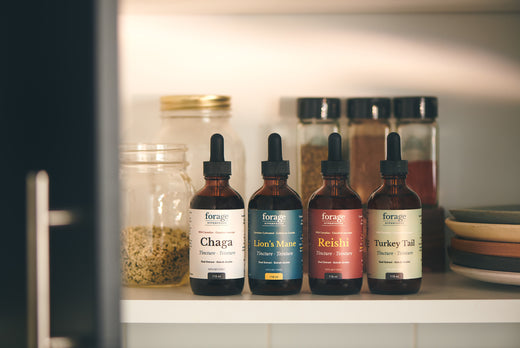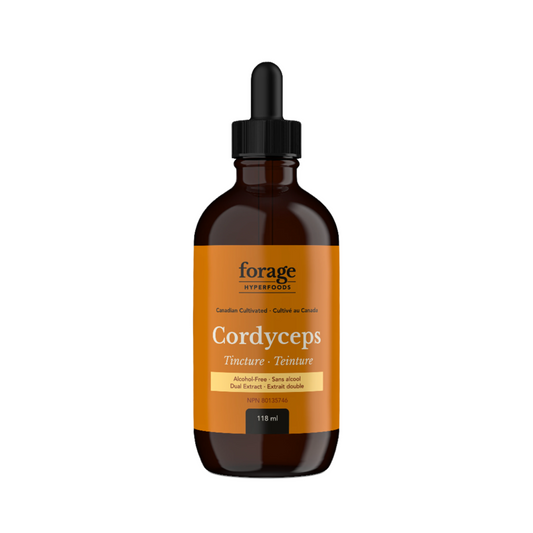
What Are Mushroom Tinctures and How Are They Made?
Share
Medicinal mushroom tinctures have become a popular wellness trend in recent years, but they’re not a new discovery. Tinctures have been used to draw out active ingredients from plants for thousands of years.
In this article, we’ll explain everything you need to know about mushroom tinctures, including what they are, how they’re made, and their benefits.
What is a mushroom tincture?
A mushroom tincture is a concentrated liquid extract that's made by soaking fresh or died mushrooms in a solvent—typically alcohol and/or water. This process unlocks the active ingredients in the mushrooms, leaving you with a potent liquid that can be dosed with a pipette.
A brief history of tinctures
Due to their recent rise in popularity, you might think that tinctures are a new product, but they’ve actually been used for ages. Since ancient Egyptians first distilled alcohol, people have been using solvents to produce potent plant extracts for medicinal purposes.
When pharmacology emerged in the 19th Century, the use of tinctures in medicine tapered off, as they were replaced with pills. In the past few decades, however, there’s been a growing interest in natural therapies, paving the way for tinctures to make a comeback.
What are the benefits of tinctures?
Functional mushrooms contain several bioactive and therapeutic compounds, such as polysaccharides and triterpenes, however, these compounds are locked behind the mushroom’s cell wall. The cell wall is made of a strong substance called chitin—the same substance that makes up the tough shell of crabs, lobsters, and insects.
The human body is unable to break down chitin, so to unlock the beneficial compounds locked behind the chitin cell wall, the mushrooms have to go through an extraction process. Soaking the mushrooms in a solvent like alcohol breaks down the chitin, which releases the nutritive compounds, enabling you to reap the full benefits of medicinal mushrooms.
Mushroom tinctures are very concentrated, meaning you’ll receive an abundance of high-potency nutrients in a small amount of liquid—much more than you could receive from mushrooms in any other form.
To top it off, tinctures are exceptionally easy to digest and convenient to consume. They can be added to any beverage or even soft foods like soups and sauces. Tinctures are particularly helpful for those who have trouble swallowing capsules.
How are mushroom tinctures made?
Traditional tinctures are made with alcohol, however, hot water and glycerin are also sometimes used as solvents. Let’s explore how the different types of extraction work.
Hot water extraction
If you drink tea, you’re familiar with hot water extraction. The mushrooms are simmered below boiling point for many hours with this method. The remaining solid plant material is strained out and discarded.
Hot water extracts are typically used for preparing mushroom supplements because the main active ingredient in these mushrooms (beta-glucans) is water-soluble.
Alcohol extraction
In an alcohol extraction, mushrooms are combined with alcohol and left to sit for several weeks to months. Alcohol extracts are typically used to isolate triterpenoids, sterols, and flavonoids, which are non-water-soluble active compounds found in some mushrooms.
Glycerin extraction
Glycerin is another effective solvent that extracts constituents from mushrooms without the use of alcohol. The extraction process is the same as with water and alcohol, except glycerin is used as the solvent.
Glycerin is a clear, colourless, and odourless liquid with a very sweet taste and syrup-like consistency. Glycerin has anti-fermentative properties that are efficient for preservation, although glycerin-based tinctures have a slightly shorter shelf life than alcohol-based ones.
Dual extraction
In some cases, using both hot water and alcohol extraction may be beneficial—a method referred to as dual extraction. The material is first extracted with either hot water or alcohol with this method. Next, the remaining plant material is extracted again with the other solvent. Finally, the liquid from the first extraction is combined with the liquid from the second extraction, forming what is called a dual extract.
A new type of extraction
Here at Forage Hyperfoods, we use industry-leading ultrasonic extraction technology to produce high-potency dual extracts that feature all of the mushroom’s beneficial polysaccharides, triterpenes, and vitamins. This method is the most efficient at breaking down chitin to release active compounds contained in fungal cell walls, delivering a potent and bioavailable liquid extract.
With ultrasonic extraction, an ultrasonic system sends waves (or mechanical vibrations) through the liquid. This causes large pressure changes which create tiny pressure bubbles on the surface of the mushroom cells floating around in the liquid. These eventually implode, causing an opening in the mushroom cell wall that releases the inner constituents (a.k.a “the good stuff”) into the liquid.
How to select high-quality mushroom tinctures
It’s important to note that not all mushroom tinctures are created equal. Always choose mushroom tinctures made from the fruiting body, rather than mycelium. Why? Because the fruiting body contains the vast majority of the healing compounds.
At Forage Hyperfoods, we only use the fruiting body for all of our mushroom supplements and thoroughly test them for contaminants, such as heavy metals, pesticides, microbes, and gluten. We use a double extraction technique for our tinctures and offer alcohol and alcohol-free options.



